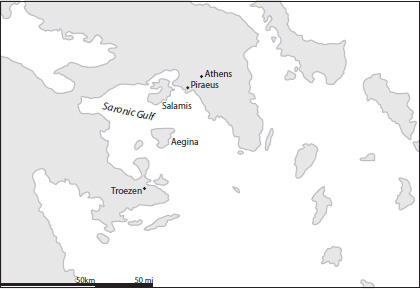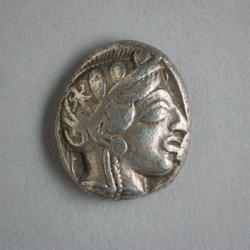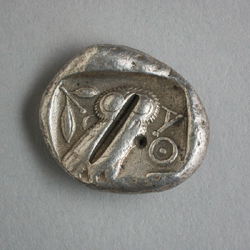Authors: Robert Garland
Wandering Greeks (18 page)

MAP 5
The evacuation of Attica before the Battle of Salamis.
An inscription found at Troezen, whose lettering is of early third-century date, purports to reproduce the text of the decree that was passed by the Council and the Assembly regarding provisions for the evacuation. Though the authenticity of the document, sometimes known as the Themistocles Decree after its prime mover, has been questioned, it is nonetheless thought to contain a “historical kernel” (
ML
p. 50). Either way it sheds an important light on the manner in which the evacuation
was envisaged to have taken place in retrospect. The relevant portion reads as follows (
ML
23.4â12 = Fornara 55):
The city is to be entrusted to Athena, the protector of Athens, and to all the other gods for them to guard and defend it against the barbarian on the country's behalf. All Athenians and
xenoi
[foreigners] living in Athens are to settle their wives and children in Troezenâ¦. [Elderly people and] possessions are to be deposited on Salamis. The treasurers and the priestesses [are to remain guarding the possessions] of the gods on the Acropolis.
If the decree was passed as soon as the Athenians learned of the Persian advance in late June, there would have been time for a relatively orderly evacuationâif indeed any evacuation can ever be described as orderly. What remains problematic is whether the decision to evacuate was taken well in advance of the arrival of the Persians but only put into effect much later; or whether two separate evacuations took place, one in late June and relatively orderly, the other in early September and more frantic. Whichever was the case, it would have been a very difficult and time-consuming operation. Indeed nothing comparable had ever been attempted before. The
metoikêsis
of the Phocaeans, which we considered earlier, had been a much smaller operation.
For several weeks families of refugees made their slow and halting way through the Attic countryside to the port of Piraeus, currently undergoing fortification, and to the open bay of Phaleron to the east, where they waited to be conveyed to safety. They had abandoned not only their homes but also everything that was precious to them. All the valuables that they could not take with themâtheir pottery, their glass bowls, and the images of their godsâthey had hastily buried in the ground. They knew the Persians, bent on revenge, would spare nothingâand so it proved. When the invaders advanced through Attica, they smashed all the funerary monuments that lay in their path and destroyed all the temples on the Acropolis (D.S. 11.14.5 and 16.2). The Athenians who had been conveyed to Salamis would have had a ringside view of the conflagration.


FIGURE 10
Attic silver
tetradrachma
(coin worth four
drachmae
), second half of fifth century. The obverse depicts the head of Athena, wearing a helmet adorned with three olive leaves, perhaps commemorating Athens's victory at the Battle of Salamis in 480. On the reverse is an owl and an olive twig with a waning moon of uncertain significance to the left. The Attic
tetradrachma
became ubiquitous in the fifth century due to Athens's political and economic hegemony. The population of Attica was evacuated during both the Persian and the Peloponnesian wars. A sizable proportion of her citizens was also deported by the Thirty Tyrants in 404.
Many of the refugees must have slept rough on the shoreline, clutching a few valuables, before a berth on board ship could be assigned to them. Priority was presumably given to the women and children, though how some semblance of order was maintained among the
mêlée
is unclear. We know little of what became of the tens of thousands of slaves. Some must have been left behind, others fled of their own accord, while those who were able-bodied were conscripted into the navy. A minority, seen as essential to the welfare of their owners, may have been evacuated. Could an Athenian live without a slave?
Plutarch evocatively describes the scene on the day of the departure to Salamis (
Them.
10.5):
As the
polis
set sail, the spectacle filled some with pity, others with admiration at the daring of the move, as the Athenians dispatched their dependents in one direction and themselves crossed over to Salamis, oblivious to the shrieks, tears, and embraces of their nearest and dearest. The many elderly, who had to be left behind, aroused compassion. Tame and
domesticated animals added to the commotion by displaying heartrending affection for their owners, running along beside them and howling as they embarked.
To add to the poignancy, Plutarch tells us that a dog belonging to Xanthippus, the father of Pericles, swam alongside the trireme that was transporting his master to Salamis, only to expire as soon as it reached dry land (10.6). A revered spot on the island known as the Dog's Tomb allegedly marked the grave centuries after.
No historian tells us how precisely the population was conveyed from Attica. A trireme's complement consisted of about 200, of whom 170 were rowers, so there would have been hardly any room for passengers. Even if it had been possible to reduce the number of rowers, conveying passengers in a vessel of this sort would have been cumbersome and hazardous. As in a canoe, even a small movement could unbalance the ship and throw the rowers into confusion. Added to which, there was no deck rail. We hear of Darius ordering the manufacture of what are called “ships for transporting horses” in advance of his expedition to Greece in 490 (Hdt. 6.48 and 95). It is not improbable that the Athenians had ships of this sort at their disposal by 480 and that they used them for transporting people. Another possibility is that they commandeered merchant ships belonging to foreigners that were docking in the Piraeus or Phaleron Bay, as well as all those that belonged to Athenian traders.
Plutarch (
Them.
10.3) tells us that the women and children who were dispatched to Troezen were warmly welcomed by the inhabitants. The Troezenians had previously passed a law to the effect that they would “support them at public expense, give two obols to each family each day, permit the boys to pluck ripe fruit everywhere, and hire teachers to educate them.” These measures suggest that they expected the refugees to be with them for some considerable time. The warmth of the reception sounds almost too good to be true and perhaps we should take it with a pinch of salt, despite the fact that Plutarch supplies the name of the man who introduced the billâan otherwise unknown Nicagoras.
Hardly surprisingly there were a number of Athenians who were reluctant to abandon their homes, hearths, temples, and tombs, and who elected instead to wait upon events. When the threat of invasion became real following the breaking of the defense line at Artemisium-Thermopylae, however, panic probably set in, even among the most hardened. The only ones who were undeterred were those who chose to interpret the oracle urging the Athenians to “trust in the wooden wall” as a reference to the wooden palisade surrounding the Acropolis. They took refuge on that rock, determined to defend it to the last.
At this point the Athenians may have appealed to the combined Greek fleet to put in at Salamis to assist them in a secondary, viz emergency, evacuation of those still remaining. It is probably this last-minute evacuation that Herodotus describes, having omitted to mention the more orderly withdrawal (8.40â41). The allies no doubt obliged, and the Athenian fleet, which now comprised and spoke for the
dêmos
, issued a proclamation to the effect that “every Athenian should do what he could to save his children and other family members”âa clear indication that the state had limited means to assist the remaining evacuees. Convinced that Athena had abandoned the Acropolis since her sacred snake was no longer taking food, “they now made haste to remove all they had.” Soon afterward, as we saw in
chapter 4
, Themistocles threatened to relocate the city permanently, should the Greek coalition decide to abandon Attica and retreat to the Isthmus of Corinth. No surviving source tells us anything about the evacuees after the Battle of Salamis, and we do not know when they actually returned to their homes.
The Athenians were not the only ones to evacuate their city in advance of the Persians. So, too, did the Plataeans and Thespians, who fled south en masse to the Peloponnese (D.S. 11.14.5). No doubt many other Greek peoples who inhabited cities in the direct line of fire, so to speak, between the Hellespont and Attica also took to their heels. Herodotus tells us that as the Persians advanced south they “destroyed everything,” sanctuaries included. They also gang-raped Phocian women, many of whom died as a result (8.33, 35, 50.2). It was these actions and others like them that earned them the name “barbarian.”
The Evacuation of Attica at the Outbreak of the Peloponnesian War
At the beginning of Aristophanes'
Acharnians
, produced in 425, Dicaeopolis, the protagonist, is standing in the Assembly awaiting the arrival of the
prytaneis
(presidents), who will declare the meeting open. He characterizes himself as “looking away in the direction of my farm, longing for peace, hating the city, and longing for my village” (ll.32â33). In view of these sentiments, there is a strong likelihood that Dicaeopolis is one of the tens of thousands of Athenians residing in rural demes who evacuated the countryside when the Peloponnesians announced their intention to ravage Attica.
Thucydides tells us that the country-dwellers were “dispirited and did not bear the change easily” (2.14; cf. 2.16.2). That is an understatement, if ever there was one, and one to which Dicaeopolis's nostalgia for the countryside gives strident utterance. Indeed the
Acharnians
might plausibly be interpreted as a commentary on the nostalgic longings of evacuees for the rural life that they have had to renounce. Their unhappiness would have been all the more acute because, as Thucydides points out, many of them had only recently rebuilt their dwellings after the destruction caused by the Persians half a century earlier.
The scale of the evacuation and the disruption it caused are scarcely imaginable. Since the majority of Athenians were living in the countryside at the time the war broke out, the population of the city would have virtually doubled overnight, increasing by between 50,000 and 100,000 (Thuc. 2.16.1).
Pericles, who was the architect of the strategy that now converted Athens, the Long Walls, and the Piraeus to a fortified island enclave, probably envisaged that the war would be over in a few months and that the refugees would be able to return to their homes at the end of the first year's fighting season. How wrong he was. They would remain cooped up for weeks on end for at least five years in the most insanitary conditions imaginable. The waste disposal system was nowhere near sufficient to deal with the huge influx of people and animals. A horrific plague soon broke out and morale was seriously undermined. Meanwhile
the Peloponnesians destroyed their homes and ravaged their crops, completely unchecked and unimpeded.
Thucydides provides few details about the evacuation. He simply notes that the refugees took from their homes not only their furniture but also whatever else was made of wood, including doors, frames, shutters, and the like, wood being in very short supply and therefore valuable (2.14). He also tells us that the Athenians “conveyed their flocks and beasts of burden to Euboea and other neighboring islands.” The fate of their pigs, goats, and chickens, as well as of their household pets, is not stated but many were presumably conveyed within the walls.
